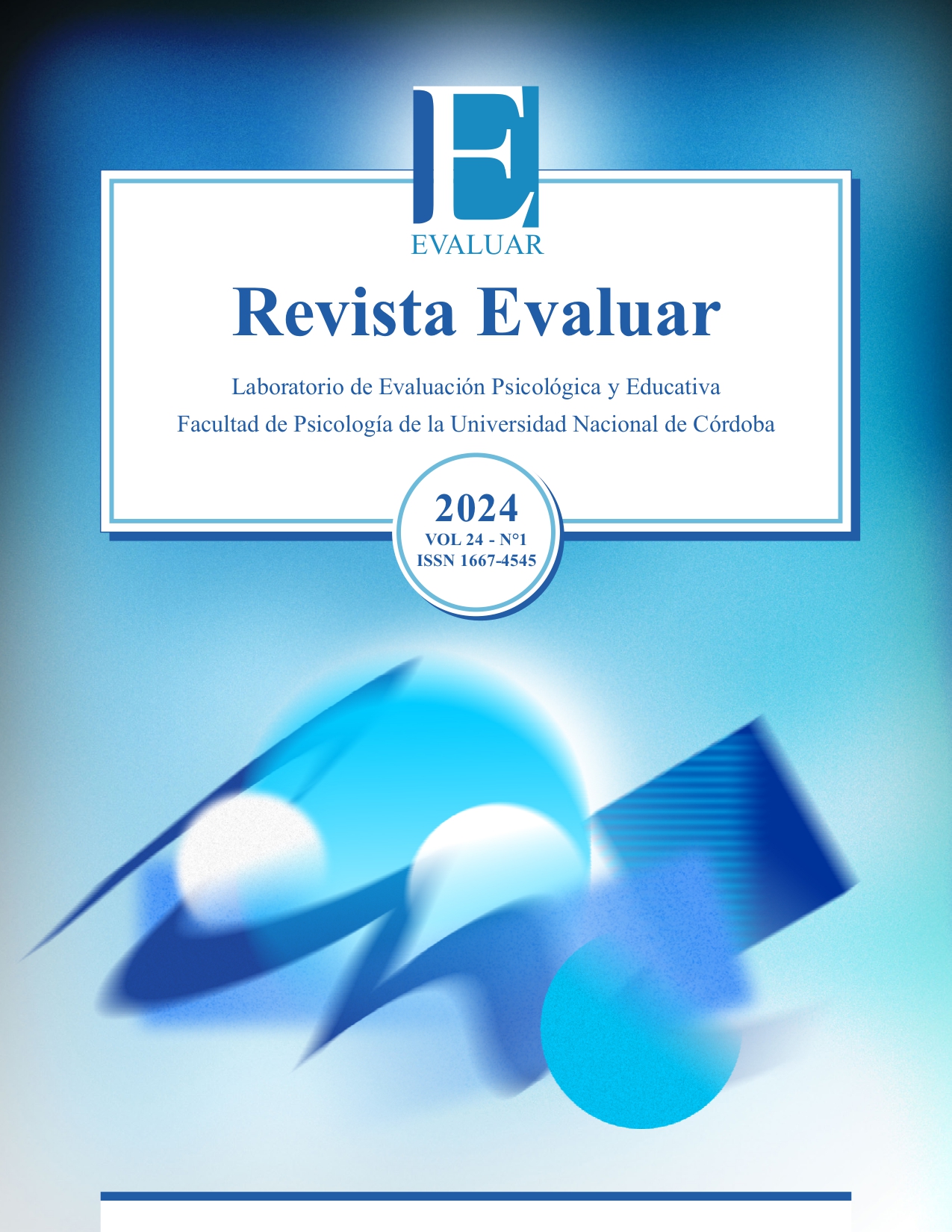Structural Analysis of the Academic Motivation Scale (Spanish version) in Graduate Students
DOI:
https://doi.org/10.35670/1667-4545.v24.n1.45122Palabras clave:
academic motivation, extrinsic motivation, intrinsic motivation, graduate students, psychometricsResumen
This research aimed to examine the factor structure of the Academic Motivation Scale (AMS) in master’s and doctoral students from universities in Puerto Rico; 300 students between 21 to 40 years (M = 29.14; SD = 4.87) participated. Confirmatory factor analysis, internal consistency, correlation, and item analysis were performed. Results of the current study provide evidence that supports the internal structure of the AMS and the ancillary statistics use of the bifactor model presents some interesting information about the possible unidimensional or multidimensional uses of the AMS. The subscales of the AMS obtained good reliability coefficients, and the AMS appears to be invariant among gender and age, which permits comparison among these groups. The use of the AMS appears useful in the educational context with graduate students in Puerto Rico. The implications and limitations of the findings are discussed.
Descargas
Citas
Alonso, J. L. N., Lucas, J. M.-A., Izquierdo, J. G. N. (2006). Validación de la Escala de Motivación Educativa (AMS) en Paraguay. Interamerican Journal of Psychology, 40(2), 185-192. https://doi.org/10.1037/t85057-000
Alonso-Tapia, J. (1998). Motivación y aprendizaje en el aula. Cómo enseñar a pensar. Santillana.
Arias, V. B., Ponce, F. P., & Nuñez, D. E. (2018). Bifactor models of attention-deficit/hyperactivity disorder (ADHD): An evaluation of three necessary but underused psychometric indexes. Assessment, 25(7), 885-897. https://doi.org/10.1177/1073191116679260
Ato, M., López-García, J. J., & Benavente, A. (2013). Un sistema de clasificación de los diseños de investigación en psicología. Anales de Psicología, 29(3). https://doi.org/10.6018/analesps.29.3.178511
Becerra-González, C. E., & Reidl-Martínez, L. M. (2015). Motivación, autoeficacia, estilo atribucional y rendimiento escolar de estudiantes de bachillerato. Revista Electrónica de Investigación Educativa, 17(3). https://redie.uabc.mx/redie
Browne, M. W., & Cudeck, R. (1989). Single sample cross-validation indices for covariance structures. Multivariate Behavioral Research, 24(4), 445-455. https://doi.org/10.1207/s15327906mbr2404_4
Bonifay, W., Lane, S. P., & Reise, S. P. (2017). Three concerns with applying a bifactor model as a structure of psychopathology. Clinical Psychological Science, 5(1), 184–186. https://doi.org/10.1177/2167702616657069
Burgueño, R., Sicilia, Á., Medina-Casaubón, J., Alcaraz-Ibáñez, M., & Lirola, M. J. (2017). Academic motivation scale revised. Inclusion of integrated regulation to measure motivation in initial teacher education. Anales de Psicología, 33(3), 670-679. https://doi.org/10.6018/analesps.33.3.249601
Byrne, B. M. (2016). Structural equation modelling with AMOS basic concepts, applications, and programming (3rd ed.). Routledge.
Candela, F., Zucchetti, G., & Villosio, C. (2014). Preliminary validation of the Italian version of the original sport motivation scale. Journal of Human Sport & Exercise, 1(9), 136-147. http://dx.doi.org/10.4100/jhse.2014.91.14
Chen, F. F. (2007). Sensitivity of goodness of fit indexes to lack of measurement invariance. Structural Equation Modeling, 14(3), 464-504. https://psycnet.apa.org/doi/10.1080/10705510701301834
Chicaiza-Ayala, W., & Cragno, A. G. (2018). Motivation in three Medical Schools in Ecuador. Educación Médica, 19, 98-104. https://doi.org/10.1016/j.edumed.2017.03.031
Cokley, K. O. (2000). Examining the validity of the Academic Motivation Scale by comparing scale construction to self-determination theory. Psychological Reports, 86(2), 560–564. https://doi.org/10.2466/PR0.86.2.560-564
Cokley, K. O., Bernard, N., Cunningham, D., & Motoike, J. (2001). A psychometric investigation of the academic motivation scale using a United States sample. Measurement and evaluation in Counseling and development, 34(2), 109-119. https://doi.org/10.1080/07481756.2001.12069027
Deci, E. L., & Ryan, R. M. (1985). Intrinsic Motivation and Self-Determination in Human Behavior. Springer. https://doi.org/10.1007/978-1-4899-2271-7
Deci, E. L., & Ryan, R. M. (2000). The “what” and “why” of goal pursuits: Human needs and the self-determination of behavior. Psychological Inquiry, 11(4), 227-268. https://doi.org/10.1207/S15327965PLI1104_01
Fairchild, A. J., Horst, S. J., Finney, S. J., & Barron, K. E. (2005). Evaluating existing and new validity evidence for the Academic Motivation Scale. Contemporary Educational Psychology, 30(3), 331–358. https://doi.org/10.1016/j.cedpsych.2004.11.001
Ferrando, P. J., & Lorenzo-Seva, U. (2017). Assessing the quality and appropriateness of factor solutions and factor score estimates in exploratory item factor analysis. Educational Psychological Measurement, 78(5), 762-780. https://doi.org/10.1177/0013164417719308
Flores-Kanter, P. E., Dominguez-Lara, S., Trógolo, M. A., & Medrano, L. A. (2018). Best Practices in the Use of Bifactor Models: Conceptual Grounds, Fit Indices and Complementary Indicators. Revista Evaluar, 18(3). https://doi.org/10.35670/1667-4545.v18.n3.22221
Fornell, C., & Larcker, D. F. (1981). Evaluating structural equation models with unobservable variables and measurement error. Journal of Marketing Research, 18(1), 39-50. https://doi.org/10.2307/3151312
Furr, R. M. (2022). Psychometrics: An introduction. SAGE.
Gutiérrez-Ruiz, K. (2015). Perfil agentivo de estudiantes con bajo rendimiento académico: Estrategias cognitivas y de control de aprendizaje, autoeficacia académica y motivación. Informes Psicológicos, 15(1), 63-81. http://dx.doi.org/10.18566/infpsicv15n1a04
Guzmán, J. F., Carratalá, E., García-Ferriol, A., & Carratalá, V. (2006). Propiedades psicométricas de una escala de motivación deportiva. European Journal of Human Movement, 16, 85-98. https://www.eurjhm.com/index.php/eurjhm/article/view/161
Hair, J. F., Black, W. C., Babin, B. J., & Anderson, R. E. (2019). Multivariate data analysis. Cengage.
Hu, L.-t., & Bentler, P. M. (1999). Cutoff criteria for fit indexes in covariance structure analysis: Conventional criteria versus new alternatives. Structural Equation Modeling, 6(1), 1-55. https://doi.org/10.1080/10705519909540118
Kline, R. B. (2016). Principles and practice of structural equation modeling (4th ed.). The Guilford Press.
Lepper, M. R. (1988). Motivational considerations in the study of instruction. Cognition and Instruction, 5(4), 289-309. https://doi.org/10.1207/s1532690xci0504_3
Li, C.-H. (2016a). Confirmatory factor analysis with ordinal data: Comparing robust maximum likelihood and diagonally weighted least squares. Behavioral Research Methods, 48(3), 936-949. https://doi.org/10.3758/s13428-015-0619-7
Li, C.-H. (2016b). The performance of ML, DWLS, and ULS estimation with robust corrections in structural equation models with ordinal variables. Psychological Methods, 21(3), 369-387. https://doi.org/10.1037/met0000093
Littlewood-Zimmerman, H. F., & Bernal-Garcia, E. R. (2011). Mi primer modelamiento de ecuacion structural LISREL. https://docplayer.es/50148837-Mi-primer-modelamiento-de-ecuacion-estructural-lisrel.html
MacCallum, R. C., Browne, M. W., & Sugawara, H. M. (1996). Power analysis and determination of sample size for covariance structure modeling. Psychological Methods, 1(2), 130–149. https://doi.org/10.1037/1082-989X.1.2.130
Marsh, H. W., Balla, J. R., & Hau, K. T. (1996). An Evaluation of Incremental Fit Indexes: A Clarification of Mathematical and Empirical Properties. In G. A. Marcoulides, & R. E. Schumacker (Eds.), Advanced Structural Equation Modeling Techniques (pp. 315-353). Lawrence Erlbaum.
Meredith, W., & Teresi, J. A. (2006). An Essay on Measurement and Factorial Invariance. Medical Care, 44(11, Suppl 3), S69-S77. https://doi.org/10.1097/01.mlr.0000245438.73837.89
Montes, S. A., & Sánchez, R. O. (2019). El factor p. ¿La estructura subyacente a la psicopatología? Revista Evaluar, 19(3), 20-41. https://revistas.unc.edu.ar/index.php/revaluar
Núñez, J. L., Lucas, J. M., Navarro Izquierdo, J. G., & Grijalvo Lobera, F. (2006). Validación de la Escala de Motivación Educativa (EME) en Paraguay. Revista Interamericana de Psicología/Interamerican Journal of Psychology, 40(3), 391-398. https://www.redalyc.org/pdf/284/28440314.pdf
Núñez, J. L., Martín-Albo, J., Navarro, J. G., & Suárez, Z. (2010). Adaptación y validación de la versión Española de la Escala de Motivación Educativa en estudiantes de educación secundaria postobligatoria. Estudios de Psicología, 31(1), 89-100. https://doi.org/10.1174/021093910790744590
Quinn, H. (2014). Bifactor models, explained common variance (ECV), and the usefulness of scores from unidimensional item response theory analyses. University of North Carolina at Chapel Hill. https://doi.org/10.17615/t6ff-a088
Reise, S. P., Moore, T. M., & Haviland, M. G. (2010). Bifactor models and rotations: Exploring the extent to which multidimensional data yield univocal scale scores. Journal of Personality Assessment, 92(6), 544-559. https://doi.org/10.1080/00223891.2010.496477
Reise, S. P., Bonifay, W. E., & Haviland, M. G. (2013). Scoring and modeling psychological measures in the presence of multidimensionality. Journal of Personality Assessment, 95(2), 129-140. https://doi.org/10.1080/00223891.2012.725437
Reyes-Cruz, M. d. R., & Gutiérrez-Arceo, J. M. (2015). Sentido de autoeficacia en investigación en estudiantes de postgrado. Sinéctica, 45. https://sinectica.iteso.mx/index.php/SINECTICA/article/view/590
Rodriguez, A., Reise, S. P., & Haviland, M. G. (2015). Applying bifactor statistical indices in the evaluation of psychological measures. Journal of Personality Assessment, 98(3), 223-237. https://www.tandfonline.com/doi/full/10.1080/00223891.2015.1089249
Rodriguez, A., Reise, S. P., & Haviland, M. G. (2016). Evaluating bifactor models: Calculating and interpreting statistical indices. Psychological Methods, 21(2), 137-150. http://dx.doi.org/10.1037/met0000045
Rodríguez, S., Núñez, J. C., Valle, A., Blas, R., & Rosario, P. (2009). Autoeficacia docente, motivación del profesor y estrategias de enseñanza. Escritos de Psicología, 3(1), 1-7. https://doi.org/10.24310/espsiescpsi.v3i1.13328
Román-Pérez, C. (2013). El buen rendimiento escolar en los estudiantes que ingresan a la universidad. Calidad en la Educación, 38, 147-179. https://doi.org/10.31619/caledu.n38.108
Rosseel, Y. (2012). lavaan: An R Package for Structural Equation Modeling. Journal of Statistical Software, 48(2), 1-36. https://doi.org/10.18637/jss.v048.i02
Ruiz, K. G. (2015). Perfil agentivo de estudiantes con bajo rendimiento académico: Estrategias cognitivas y de control del aprendizaje, autoeficacia académica y motivación. Fundación Universitaria Tecnológico Comfenalco, 15(1), 63-81. https://dialnet.unirioja.es/descarga/articulo/5229768.pdf
Sánchez, J. J. M., & Hernández-Pina, F. (2011). Influencia de la motivación en el rendimiento académico de los estudiantes de formación profesional. Revista Electrónica Interuniversitaria de Formación de Profesorado, 14(1), 81-100.
Silva, P. C. d. C., Sicilia, A., Burgueño, R., & Lirola, M. J. (2018). Academic motivation in the initial training of physical education teachers. Revista Internacional de Medicina y Ciencias de La Actividad Física y Del Deporte, 18(71), 537-554. https://doi.org/10.15366/rimcafd2018.71.009
Smits, I. A. M., Timmerman, M. E., Barelds, D. P. H., & Meijer, R. R. (2015). The Dutch symptom checklist-90-revised: Is the use of the subscales justified? European Journal of Psychological Assessment, 31(4), 263-271. https://psycnet.apa.org/doi/10.1027/1015-5759/a000233
Stark, S., Chernyshenko, O. S., & Drasgow, F. (2006). Detecting differential item functioning with confirmatory factor analysis and item response theory: Toward a unified strategy. Journal of Applied Psychology, 91(6), 1292–1306. https://doi.org/10.1037/0021-9010.91.6.1292
Tucker, L. R., & Lewis, C. (1973). A reliability coefficient for maximum likelihood factor analysis. Psychometrika, 38, 1-10. https://doi.org/10.1007/BF02291170
Vallerand, R. J., Pelletier, L. G., Blais, M. R., Brière, N. M., Senécal, C., & Vallières, E. F. (1993). On the assessment of intrinsic, extrinsic, and amotivation in education: Evidence on the concurrent and construct validity of the Academic Motivation Scale. Educational and Psychological Measurement, 53, 159-172. https:// journals.sagepub.com/toc/epma/53/1
Vallerand, R. J., Pelletier, L. G., Blais, M. R., Brière, N. M., Senecal, C., & Vallieres, E. F. (1992). The Academic Motivation Scale: A measure of intrinsic, extrinsic, and amotivation in education. Educational and Psychological Measurement, 52(4), 1003–1017. https://doi.org/10.1177/0013164492052004025
Vandenberg, R. J., & Lance, C. E. (2000). A review and synthesis of the measurement invariance literature: Suggestions, practices, and recommendations for organizational research. Organizational Research Methods, 3(1), 4-69. https://doi.org/10.1177/109442810031002
Wang, J., & Wang, X. (2012). Structural Equation Modeling Applications Using Mplus. John Wiley & Sons Ltd. http://dx.doi.org/10.1002/9781118356258
Zhang, D., Wehmeyer, M. L., & Chen, L.-J. (2005). Parent and teacher engagement in fostering the self-determination of students with disabilities: A comparison between the United States and the Republic of China. Remedial and Special Education, 26(1), 55-64. https://doi.org/10.1177/07419325050260010701
Zinbarg, R. E., Yovel, I., Revelle, W., & McDonald, R. P. (2006). Estimating generalizability to a latent variable common to all of a scale’s indicators: A comparison of estimators for ωH. Applied Psychological Measurement, 30(2), 121-144. https://journals.sagepub.com/toc/apma/30/2
Descargas
Publicado
Cómo citar
Número
Sección
Licencia
Derechos de autor 2024 Juan Aníbal González-Rivera, Ernesto Rosario-Hernández, Taimara Ortiz Santiago

Esta obra está bajo una licencia internacional Creative Commons Atribución 4.0.
Revista Evaluar aplica la Licencia Internacional de Atribuciones Comunes Creativas (Creative Commons Attribution License, CCAL). Bajo esta licencia, los autores retienen la propiedad de copyright de los artículos pero permiten que, sin que medie permiso de autor o editor, cualquier persona descargue y distribuya los artículos publicados en Evaluar. La única condición es que siempre y en todos los casos se cite a los autores y a la fuente original de publicación (i.e. Evaluar). El envío de artículos a Evaluar y la lectura de los mismos es totalmente gratuito.




_(3).jpg)



.jpg)



